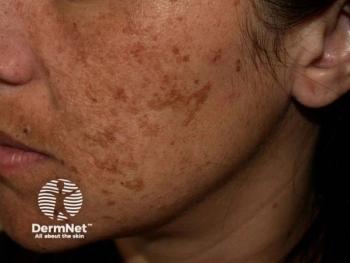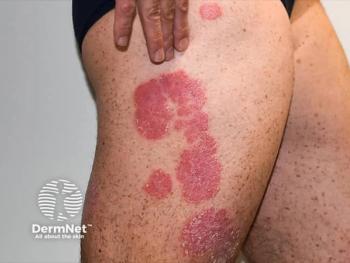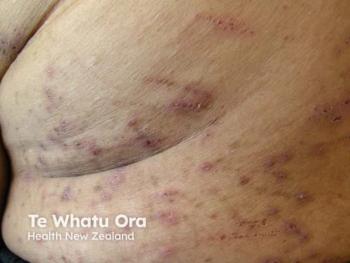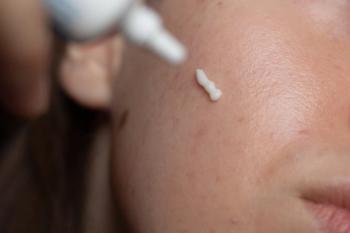
Tapinarof Cream 1% Demonstrates Efficacy in Treating Atopic Dermatitis in Young Patients with Skin of Color
Tapinarof cream 1% has proven to be an effective and safe treatment for atopic dermatitis in diverse populations, according to a poster presented at the SPD's annual meeting.
A recent study, presented in a poster at the
Background and Methods
The ADORING 1 and ADORING 2 trials were conducted to assess the effectiveness of tapinarof cream 1% applied once daily. The trials included patients aged 2 years and older with moderate to severe AD, characterized by a Validated Investigator Global Assessment for Atopic Dermatitis (vIGA-AD) score of greater than or equal to 3, an Eczema Area and Severity Index (EASI) score of greater than or equal to 6, and body surface area involvement of 5-35%. Participants were randomized in a 2:1 ratio to receive either tapinarof cream or a vehicle cream for 8 weeks.
Findings
Efficacy Across Diverse Skin Types
The study's results were promising across various racial groups and Fitzpatrick skin types. Among the 407 and 406 randomized patients, the demographics included 8.8-15.3% Asian, 26.5-35.0% Black, 44.8-56.8% White, and 2.7-5.2% from other racial groups. Notably, more than 50% of participants had Fitzpatrick skin types IV, V, and VI.
Primary and Secondary Endpoints
The primary efficacy endpoint was achieving a vIGA-AD score of 0 (clear) or 1 (almost clear) with a greater than or equal to 2-grade improvement from baseline at week 8. Secondary endpoints included achieving a 75% improvement in EASI (EASI75).
Across all racial groups, tapinarof demonstrated superior efficacy compared to the vehicle. Specifically:
- Asian Patients: 39.5-48.9% achieved vIGA-AD responses with tapinarof compared to 3.7-18.5% with the vehicle.
- Black Patients: 43.1-47.0% achieved vIGA-AD responses with tapinarof compared to 17.5-24.1% with the vehicle.
- White Patients: 49.4-52.1% achieved vIGA-AD responses with tapinarof compared to 12.2-14.5% with the vehicle.
- Other Racial Groups: 26.0-44.8% achieved vIGA-AD responses with tapinarof compared to 0.0-40.2% with the vehicle.
EASI75 responses were similarly favorable across these groups, with significant improvements in patients treated with tapinarof.
Safety Profile
Tapinarof cream was well-tolerated across all patient groups. Adverse events were mostly mild to moderate in intensity and resolved over the treatment period.
Conclusions
"Tapinarof cream 1% QD was consistently efficacious among all racial groups and Fitzpatrick skin types, including adults and children down to 2 years of age with AD and skin of color, who comprised approximately 50% of patients in these trials," according to Alexis et al.
Continued research and longer-term studies are necessary to confirm these promising results and to further explore the long-term benefits and safety of tapinarof cream 1%, according to poster authors.
In April, Dermavant Sciences announced the US Food and Drug Administration's acceptance of their supplemental new drug application (sNDA) for tapinarof cream 1% to treat AD in individuals aged 2 and older. The sNDA submission is backed by data from the phase 3 ADORING 1 and 2 trials, an open-label pharmacokinetics trial in children, and interim results from the ADORING 3 extension trial. The Prescription Drug User Fee Act date is anticipated in the fourth quarter of 2024.2
References
- Alexis AF, Kircik L, Chovatiya R, et al. Tapinarof cream 1% once daily is efficacious for the treatment of atopic dermatitis in patients with skin of color down to 2 years of age in two pivotal phase 3 trials. Poster presented at: 2024 Society for Pediatric Dermatology Annual Meeting; 2024; Toronto, ON.
- Dermavant announces FDA acceptance of supplemental new drug application (sNDA) for VTAMA (tapinarof) cream, 1% for the treatment of atopic dermatitis in adults and children 2 years of age and older. News release. Dermavant Sciences. April 29, 2024. Accessed July 12, 2024.
https://dermavant.com/dermavant-announces-fda-acceptance-of-supplemental-new-drug-application-snda-for-vtama-tapinarof-cream-1-for-the-treatment-of-atopic-dermatitis-in-adults-and-children-2-years-of-age-and-old/
Newsletter
Like what you’re reading? Subscribe to Dermatology Times for weekly updates on therapies, innovations, and real-world practice tips.


















